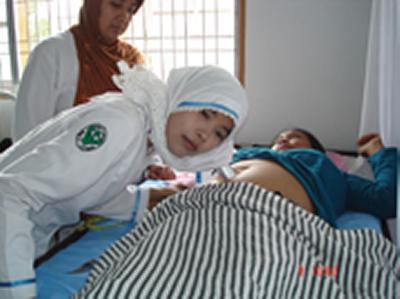Adequate midwifery could save over 3-million lives

Up to 3.6 million lives could be saved every year if midwifery services were upgraded in 58 developing countries by 2015, according to a major new report released by the United Nations Population Fund (UNFPA), in partnership with the University of Southampton and 28 other organisations worldwide.
The State of the World’s Midwifery 2011 reveals new data confirming there is a significant gap between the numbers of midwives practising and those needed to save lives.
Southampton statistician and social scientist Professor Zoë Matthews played a crucial role in compiling the data and writing large sections of the report. Zoë says, “We collected completely new data on the midwifery workforces in 58 ‘resource poor’ countries where nearly 60 per cent of the world’s babies are born. What we found were three huge gaps.
“First, there are not enough midwives. Second, women often cannot access care. Third, and most crucially, there is an urgent need to upgrade midwives’ competencies in places where education, regulation and support for the profession are not strong.”
Each year, 358,000 women die while pregnant or giving birth, some two million newborns die within the first 24 hours of life and there are 2.6 million stillbirths, all because of inadequate or insufficient healthcare.
“The report points to an urgent need to train more health workers with midwifery skills and ensure equitable access to their life-saving services in communities to improve the health of women and children,” says Dr Babatunde Osotimehin, Executive Director of UNFPA.
The State of the World’s Midwifery 2011 reveals that unless competencies among existing midwives are addressed and an additional 112,000 midwives trained, deployed and retained in supportive environments, many of the 58 countries surveyed will not meet their target to achieve the internationally-agreed goal that all pregnant women should have a skilled health worker to assist at the time of birth (as required by United Nations Millennium Development Goal 5 on maternal health).
If adequate facilities were accessible to deal with complications at their onset, many deaths could be averted – 61 per cent or nearly two thirds of all maternal deaths, 49 per cent or almost half of stillbirths, and 60 per cent or 3 in 5 newborn deaths. The report adds that if midwives are in place and can refer the most severe complications to specialist care, up to 90 per cent of maternal deaths could be prevented.
“The good news is that, when women are within reach of a midwife supported by a functioning health system, not only is their likelihood of dying from the complications of childbirth drastically reduced, but also the midwife becomes the critical link to well-baby care and healthcare for the entire family,” says Lennie Kamwendo, Chairperson, Board of Trustees, White Ribbon Alliance for Safe Motherhood – Malawi. “We must prioritise investment in midwives to deliver life-saving care in the communities where mothers are needlessly lost.”
The report was launched at the Triennial Congress of the International Confederation of Midwives (ICM) in Durban, South Africa (Monday 20 June).

Further information
The State of the World’s Midwifery 2011, coordinated by UNFPA, is the result of collaboration among 30 partners whose collective aim is to strengthen midwifery practices to prevent maternal death and disability, and improve the health of newborns, families, and entire communities. The report surveyed 58 countries, which together account for just under 60 per cent of all births worldwide, but 91 per cent of all maternal deaths.
Among the 38 countries most desperately in need of midwives, 22 need to double the workforce by 2015; seven need to triple or quadruple it; and nine (Cameroon, Chad, Ethiopia, Guinea, Haiti, Niger, Sierra Leone, Somalia and Sudan) need to dramatically scale up midwifery by a factor of between 6 and 15.
Most deaths or disabilities occur in low-income countries and happen because women – often poor and marginalised – have no access to functioning health facilities or to qualified health professionals, notably those with midwifery skills.
Increasing women’s access to quality midwifery has become a focus of global efforts to realise the right of every woman to the best possible healthcare during pregnancy and childbirth. It is also at the heart of three health-related Millennium Development Goals – to reduce child death (MDG 4), improve maternal health (MDG 5) and fight AIDS, malaria and other diseases (MDG 6).
In addition to inadequate numbers of midwives, the report reveals that coverage within countries is unequal, as is quality. There is a shortage of training institutions and employment opportunities for midwives. In addition, poor regulation, weak professional associations, an incomplete policy environment, and the omission of midwifery from human resource costing plans for maternal and neonatal health are significant challenges.
The report makes a series of recommendations to governments, regulatory bodies, educational institutions, professional associations and international organisations that would help remedy these problems and reinforce the status of midwifery in the 58 countries surveyed.
Ends
More about UNFPA